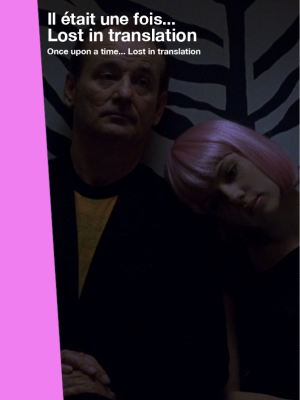ONCE UPON A TIME… LOST IN TRANSLATION
| Director | Guillaume Tunzini |
| Writers |
Guillaume Tunzini and Serge July |
| Image | Guillaime Tunzini, Casey McBeath, Malo Delarue, Yoshiyuki Matsumoto |
| Sound | Joël Flescher, Joël Hirschfeld, Hiroyuki Saijyo |
| Editing | Barbara Bascou |
| Length |
52 mins |
| Format |
HDCam, 16/9e |
| Versions |
french and english |
| Broadcaster |
ARTE |
| Copyrights |
Folamour – ARTE France – 2015 |
- Sofia COPPOLA, director
- Ross KATZ, producer
- Mitch GLAZER, Associate Producer
- Kiyoshi INOUE, producer
- Nicolas SAADA, critic and filmmaker
- Lance ACORD, Chief Operator
- Brian REITZELL, Composer, Music Director
- Blake CRAWFORD, Bill Murray’s understudy
- Marc AUGÉ, anthropologist
- Ricky HASHIMOTO, co-producer
- Diamond YUKAI, musician, actor
Once upon a time… Lost in Translation tells the genesis, the story and the success of Sofia Coppola’s second film, released in 2003. A low-budget but highly acclaimed auteur film, which won the Oscar for best screenplay, the Cesar for best foreign film, and the Golden Globe for best actor to Bill Murray.
Bob (Bill Murray), an American star on the decline, travels to Japan to shoot a commercial. Charlotte (Scarlett Johansson), an American bride, accompanies her husband on a press trip. Idle, disorientated, neglected, they are both as lost in their lives as they are in Tokyo. Romantic and short-lived, their brief relationship will change their lives.
In Once upon a time… Lost in Translation, Sofia Coppola describes her fascination with Japan and her documentary highlights the cultural shock that a Westerner experiences when discovering this country, its combination of tradition and hyper-modernity, its uniqueness exacerbated by the language barrier. Sofia Coppola also recounts how she had to stalk Bill Murray for a year before he accepted to play Bob.
The entire film team relates the comical adventures of an eventful shooting in Tokyo, illustrated by a delicious and unprecedented “making-of” of the film, in which viewers discover that it wasn’t only the fictional characters that were “lost in translation”.


 EN
EN FR
FR